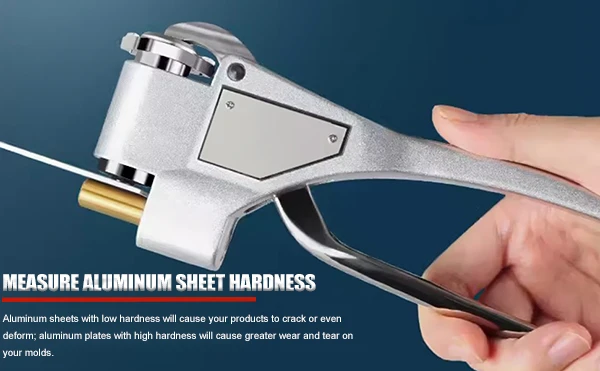Why do you need to test the hardness of aluminum sheets? Imagine what would happen if you used aluminum sheets that did not meet the hardness standards to produce products. Aluminum sheets with low hardness will cause your products to crack or even deform; aluminum plates with high hardness will cause greater wear and tear on your molds.

Hardness is the ability of a material to resist deformation. For different stamping machines, aluminium sheeting needs to have different hardness levels. The correct hardness can ensure the temperature resistance of stamping, reduce product defects and scrap rates, and affect your production costs and efficiency.
Measure Aluminum Sheet Hardness Methods
Brinell hardness test: This method uses a steel ball with a larger diameter as an indenter, presses it into the material surface, and calculates the hardness value based on the indentation diameter. It is suitable for softer materials such as aluminum and copper alloys. The unit of Brinell hardness is HBW.
Rockwell hardness test: Use a conical diamond or steel ball as the indenter, and read the hardness value directly according to the indentation depth. Rockwell hardness test is fast and easy to operate and is suitable for various metal materials. The unit of Rockwell hardness is HRC.
Vickers hardness test: Use a pyramid-shaped diamond indenter to calculate the hardness value by measuring the diagonal length of the indentation. This method is suitable for measuring the hardness of thinner materials or surface-hardened layers. The unit of Vickers hardness is HV.
Webster hardness test: This method uses a portable hardness tester, which is suitable for quickly measuring the hardness of aluminum alloys on site, especially at production sites and construction sites. You only need to use the Webster hardness tester to press down the pressure array, and the depth of the pressure needle determines the hardness of the material. The Webster hardness unit is HW.
Standards Of Aluminum Sheet Hardness Testing
In fact, the most commonly used method is the Brinell hardness test method.
For aluminum alloys with many test pieces and the desire to quickly measure the results, the Rockwell hardness test method can be used for testing.
Some special products, such as aluminum foil, aluminum strip, and instruments made into ultra-fine parts, can be tested using the Vickers test method.
The Webster hardness method is often used to test the hardness of construction aluminum alloy profiles during production and use.
Large aluminum alloy castings, forgings, etc. that are not easy to sample should be tested using the Leeb hardness test method.
| Normas | Standard Name | Applicable Scope |
| ASTM E10 | Standard Test Method for Brinell Hardness Determination. | Applicable to Brinell hardness test of metallic materials, especially aluminum and its alloys. |
| ASTM E18 | Standard Test Method for Rockwell Hardness Determination. | Applicable to Rockwell hardness test of various metallic materials, including aluminum alloys. |
| ASTM E384 | Standard Test Method for Vickers and Knoop Hardness Determination. | Applicable to Vickers and Knoop hardness test of various materials, suitable for thin plates and small samples. |
| ISO 6506 | Determination of Brinell Hardness of Metallic Materials. | International standard, applicable to test method and result evaluation of Brinell hardness. |
| ISO 6507 | Determination of Vickers Hardness of Metallic Materials. | International standard, applicable to Vickers hardness test. |
| ISO 6508 | Determination of Rockwell Hardness of Metallic Materials. | International standard, applicable to Rockwell hardness test. |
| GB/T 230.1 | Determination of Rockwell hardness of metal. | Chinese national standard, applicable to Rockwell hardness test method. |
| GB/T 231.1 | Determination of Brinell hardness of metal. | Chinese national standard, applicable to Brinell hardness test method. |
How To Choose The Appropriate Aluminum Sheet Hardness
Aluminum sheet hardness is very important for the stamping process. The appropriate aluminum sheet hardness will have a good stamping effect. The following are some key factors for choosing the appropriate hardness of aluminum sheet:

Stamping Depth
If the stamping process is simple and the depth is shallow, H14 and H16 will be more suitable. Because H14 and H16 have good plasticity and are easy to deform. For deep stamping products, you should choose medium-hardness aluminum sheet such as H18 temper.
Stamping Dies
Soft aluminum alloys cause less wear on stamping dies, while hard aluminum sheets cause greater wear on stamping dies, especially under frequent and high-intensity stamping.
Surface Quality Requirements
If your stamping products have high requirements for surface quality, you usually choose medium hardness. If the surface quality requirements are not high, harder aluminum sheets can provide better strength, but there may be defects on the surface.
Stamping Speed
H14 and H16 soft alloys are suitable for large-scale production, with faster stamping speed and less prone to cracking. Hard aluminum alloys (such as H18 and H19) require higher pressure during the stamping process and have low production efficiency.
In short, if you don’t know how to measure the hardness of aluminum sheets, you can ask your supplier for samples. Put the samples they provide you on your own machine for testing. If the product is successfully stamped out, then the hardness of their aluminum sheets is qualified.


